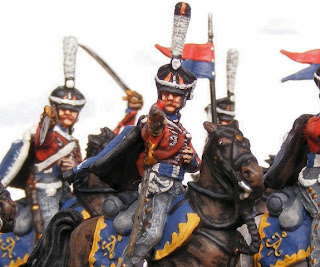"Hurrah-ah-ah!" reverberated in the forest, and the Cossack companies,
trailing their lances and advancing one after another as if poured out
of a sack, dashed gaily across the brook toward the camp.
One desperate, frightened yell from the first French soldier who saw the
Cossacks, and all who were in the camp, undressed and only just waking
up, ran off in all directions, abandoning cannons, muskets, and horses.
War & Peace Chapter VI, Book 13
A shipment arrived yesterday from our man in Budapest. I had intended to take pictures of them, but it seemed that I was unlikely to better the photographs taken by the man himself.
These are Zvesda Lifeguard Cossacks and to be fair, they are generally considered to be some of Zvesda's lesser work. That may actually be the case, but I think that merely highlights the stellar quality of the vast majority of Zvesda sculpts. But that aside, I think TK has done some wonderful work on these.
The Russian army in the latest expansion only requires one Guard Light Cavalry unit and I think these fulfill that role admirably. The Lifeguard Cossacks and the Lifeguard Hussars were a conjoined unit originally, though they were seperated soon after they were raised.
The cossacks were raised by Czar Paul and reached a strength of seven squadrons (six field, one depot) by 1812. They look rather well, but I've found precious little about their service in the field. The few British observers I've come across rate the Russian Lifeguard rather highly, but the only reference I've found to their deployment in battle refers to the Battle of Leipzig in 1813.
In 1813 at the Battle of Leipzig the Lifeguard Cossacks counterattacked the French and Saxon cuirassiers from the front while the Prussian Neumark dragoons and Silesian cuirassiers struck from the eastern flank. It was too much for the French, they were pushed back everywhere and pursued until the positions of Drouot's batteries. The pursuers were halted only by artillery fire and counter-attack made by the Old Guard dragoons.
Marbot explained why this happened: "This treatment resulted in the enemy centre yielding and it was about to give way when the Tzar of Russia who had witnessed the disaster, rapidly advanced the numerous cavalry of his Guard which, encountering the squadrons of Latour-Maubourg in the state of confusion which always follows an all-out charge, repelled them in their turn and took back 24 of the guns which they had just captured." Tsar Alexander seeing the charge of the Lifeguard Cossacks, exlaimed: "They are going into fight as if they were coming to a wedding."
(taken from here.)
Command & Colours Napoleonics rates Guard Light Cavalry as a four strength Guard unit. So they are equal to the French Guard Light Cavalry, in fact they may actually be slightly better as they may ignore two flags, which makes them particularly tenacious in battle.
Regardless of any question of their effectiveness, they are handsome and I'm really pleased to have them on the strength as they bring tone to what would otherwise be an unsightly scuffle. This latest batch has pricked me to step up my infantry basing efforts, so that I can get the infantry and the regular cossacks off to Mark.
So inch by inch my Russian army grows.
It's probably a waste, but I still love having individualised casualty markers. I think I'm going to have to come up with some way of storing them efficiently.



















































































